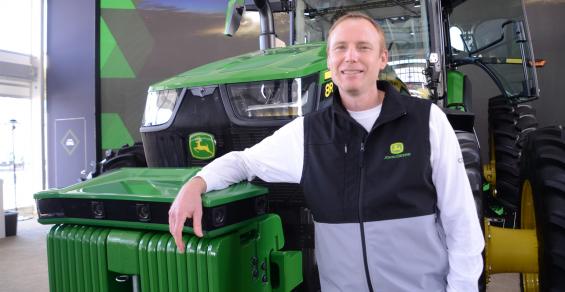Jahmy Hindman is the company’s first chief technology officer, providing his take on a range of issues.
A funny thing happens when you ask two questions at of Jahmy Hindman, chief technology officer. The first question: How long have you been CTO? And the answer is 18 months. The second question: How long has Deere had a CTO? The answer is the same.
Jahmy Hindman is the first at John Deere to hold the title, and as the company delves more into the miracle marriage of technology and machinery, his role is to guide that process for the future. He is responsible for building Deere’s “tech stack” — the company’s intuitive end-to-end equipment solution made up of hardware and devices, embedded software, connectivity, data platforms and applications. He also leads John Deere’s Intelligent Solutions Group and is responsible for a global network of technology-innovation centers and the shared engineering function.
With more than 20 years of advanced technology, artificial intelligence, product engineering and manufacturing experience, Hindman brings a diverse perspective to his role. He got his bachelor’s degree at Iowa State University — where, by the way, his father was a professor of aeronautical engineering. His master’s and doctoral degrees in mechanical engineering came from the University of Saskatchewan.
Farm Progress got some one-on-one time with Hindman at CES in Las Vegas, just after the company’s announcement of the launch of its first autonomous tractor system. Here’s a Q&A with Hindman covering that launch and several other issues.
The autonomous tractor project was well underway before you became CTO. Did you know about it — or was it under wraps, and you learned about it when you got to the new position? I had tractor engineering prior to this job, so this project was not new to me. I had full visibility of the program.
When you came in 18 months ago, you had to pull the trigger on this launch. Why 2022, versus later like 2023? What tipped you to do it now? We had been working with growers on this for three to four years, and they were telling us that it’s ready. It’s adding value now. When you’ve got the customer telling you that’s a pretty good confirmation, that there’s something there.
Yet we’re going to be cautious with it; we’re going to limit the number of units that we’re going to produce in the first year. We want to make sure it’s right before we pump it out in large quantities and extend it across the ag industry.
The idea of an autonomous tractor will appeal to some farmers, but others have a great deal of pride behind the wheel of their capital investment. How do you see the market for autonomous machines? I think there’s a spectrum. I’m not sure it’s bifurcated. I think there are growers who will look at this as an opportunity to augment the time and the day — to take eight hours out of the day, and I’m going to go do something else at that time. And the rest of the time, I will actually go and operate [the tractor] for the remainder of the day.
There are growers who will say, “This is great. I’m going to drop it off in a field and let it rock and roll and do its thing.” And there will be some who want to run this tractor and want to drive. And some will want to sit in the tractor while it is doing its autonomous work — before they have confidence in it and gain trust in it. And you know, that’s why the cab’s still on the tractor.
John Deere has used artificial intelligence and sensors with other machines. Is this just a matter of designing the ones for this machine? It’s a different sensing problem right now. We’re trying to sense objects in space, as opposed to hydraulic pressures and the positions of linkages and those sorts of things. So the problem is different, which drives the difference in the technology.
What do you see for the future of John Deere? The autonomous tractor is a big step, but where are you going? I think autonomy is a big thing, and it’s going to be a big thing for a while. So this is a baby step compared to what’s coming down the road.
This is autonomous tillage. You can pretty easily forecast in your mind: We’ll have autonomous planting at some point, an autonomous grain cart, eventually autonomous spraying. The list goes on and on, and that’s super-exciting.
You have to get autonomy all the way through the production steps in order for it to maximize value to a grower, because you don’t really separate yourself from the labor need completely until you can make all those steps autonomous.
Deere machines had a lot of automated features. What role have those features played in this move to autonomy? I think we’ve fundamentally conditioned operators of agricultural equipment over the last two decades, frankly, for an end state that is autonomy. We’re one of the few industries where I would argue customers are actually asking us, “When can I get out of the cab of this tractor?”
A farmer on the show floor today told me he planted a quarter section without having to touch the steering wheel last spring. He asked, “Why am I still here?” That’s the way we’ve conditioned the customer, so they’re ready.
Does this technology bring more to the farm than what might be immediately apparent? I think that, interestingly enough, there’s a data element to this that we are just scratching the surface of — which is that this machine is effectively the eyes now of the farmer in the field.
You can start to wrap your mind around all the things that a farmer’s looking at while they’re in the field: what they’re making sense of, what they’re rationalizing that’s important to them — and they’re no longer in the field. So what else are they going to want to use that image information for?
I’ve got a fence down over there; I’ve got a ditch issue over here that’s not draining. Those are the things that, if you have access to that information, and you’re not there to see it personally, you can still extract value. Right now, we’re only using sensors for perception, but there are other uses for that information.
To change the subject, let’s deal with the elephant in the room — to repair. How do you deal with that? We fundamentally very much support the right of a farmer to repair their equipment. That said, there are certain elements of modern farm equipment that are regulated into existence. Things like emissions on engines, things like safety requirements that we have to follow in order to satisfy certain regulations in different parts of the world. And we’re pretty sensitive about people messing with that. We want to make sure that’s done right.
I use the example of this 8R tractor that’s 40,000 pounds of machine going down the road at 23 miles an hour, separated by a little white line from that family in a minivan. Do you really want the software controlling the steering in that tractor to be touched by somebody other than the people that designed it, developed it and tested it? Do you have confidence in that? Unfortunately, that’s the reality of modern equipment.
How does autonomy play into that equation? Along with autonomy comes a whole lot of software and sensing capability. We want to make sure all that [technology] is working in concert and working together, because we have to meet the regulatory environment — and we owe it to society to produce a safe product.
You’re the first CTO at Deere. How do you look at your position at the company? It’s been interesting. We, as a company, have pivoted around this idea of a smart industrial, bringing technology to bear on the problems that the customers have.
That’s the exciting part for me as an engineer: that technology is an enabler, it’s a way to solve issues for growers. And I think the formalization of this for the company, frankly, gives us a whole new focus. You can marshal the resources of a large company to bring them to bear on a problem like autonomy in agriculture.
What does it take to get to autonomy? It doesn’t happen unless you can focus the complete resources of the company all the way, from the base tractor through that perception stack and the cameras and the [graphic processing units] and the wiring harnesses. That all has to work as a system.
And I would say in our old structure, we were more compartmentalized by product type, and that was much harder to do. In the new structure, with technology all brought together sort of under one umbrella, we work much more efficiently.
Are you aiming to be perceived as a machinery company or a technology company? The way to think about it is that we have to have both. You certainly have to have the equipment — that’s the foundation of everything. I’d be the first to say, as the former tractor engineering guy, that if the transmission doesn’t work in this tractor [pointing to the autonomous 8R on display], it doesn’t matter how well the perception system works.
It’s a blessing, from a Deere perspective, that we’ve got world-class equipment; it performs reliably in the applications that it’s put into. On top of that, we get to build in this functionality and capability that enables [autonomous operation]. It’s not an “either/or” — it’s an “and” proposition. I think it has to be.





